Contemporary Issues in Business: Analyzing Cybersecurity in Banks
VerifiedAdded on 2023/06/11
|21
|7343
|214
Essay
AI Summary
This essay explores contemporary issues in cybersecurity within the banking sector. It emphasizes the increasing importance of cybersecurity due to the rise in cyber-attacks and the integration of internet-connected systems. The essay discusses the role of cybersecurity in protecting sensitive data, preventing unauthorized access, and maintaining customer trust. It also covers the challenges faced by banks in adapting to evolving cyber threats, the elements of effective cybersecurity, and examples of cyber-attacks in the banking industry, such as the Carbanak malware and phishing campaigns. The importance of proactive and adaptive approaches to cybersecurity, along with investments in advanced technologies, is highlighted. Desklib provides students access to resources such as past papers and solved assignments.
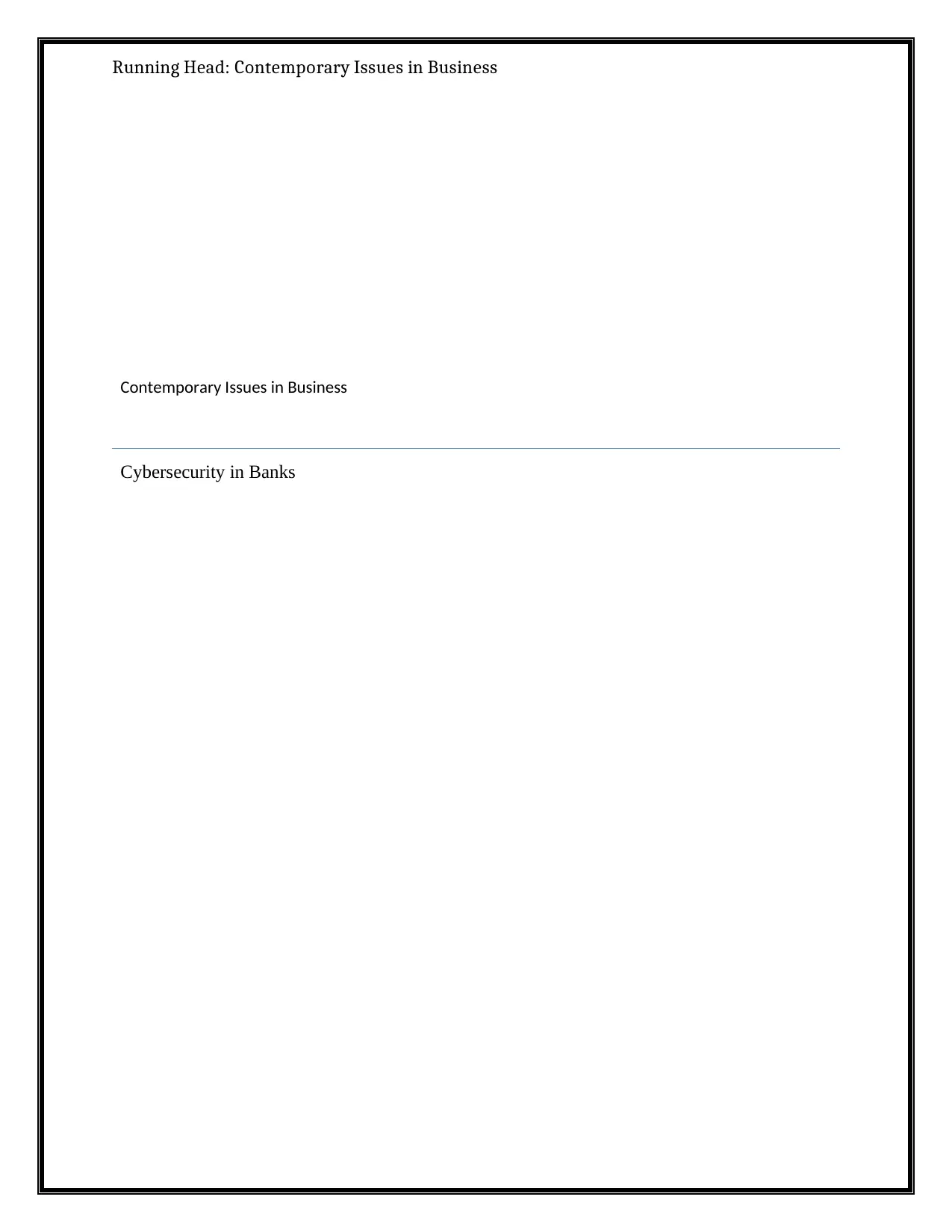
Running Head: Contemporary Issues in Business
Contemporary Issues in Business
Cybersecurity in Banks
Contemporary Issues in Business
Cybersecurity in Banks
Paraphrase This Document
Need a fresh take? Get an instant paraphrase of this document with our AI Paraphraser
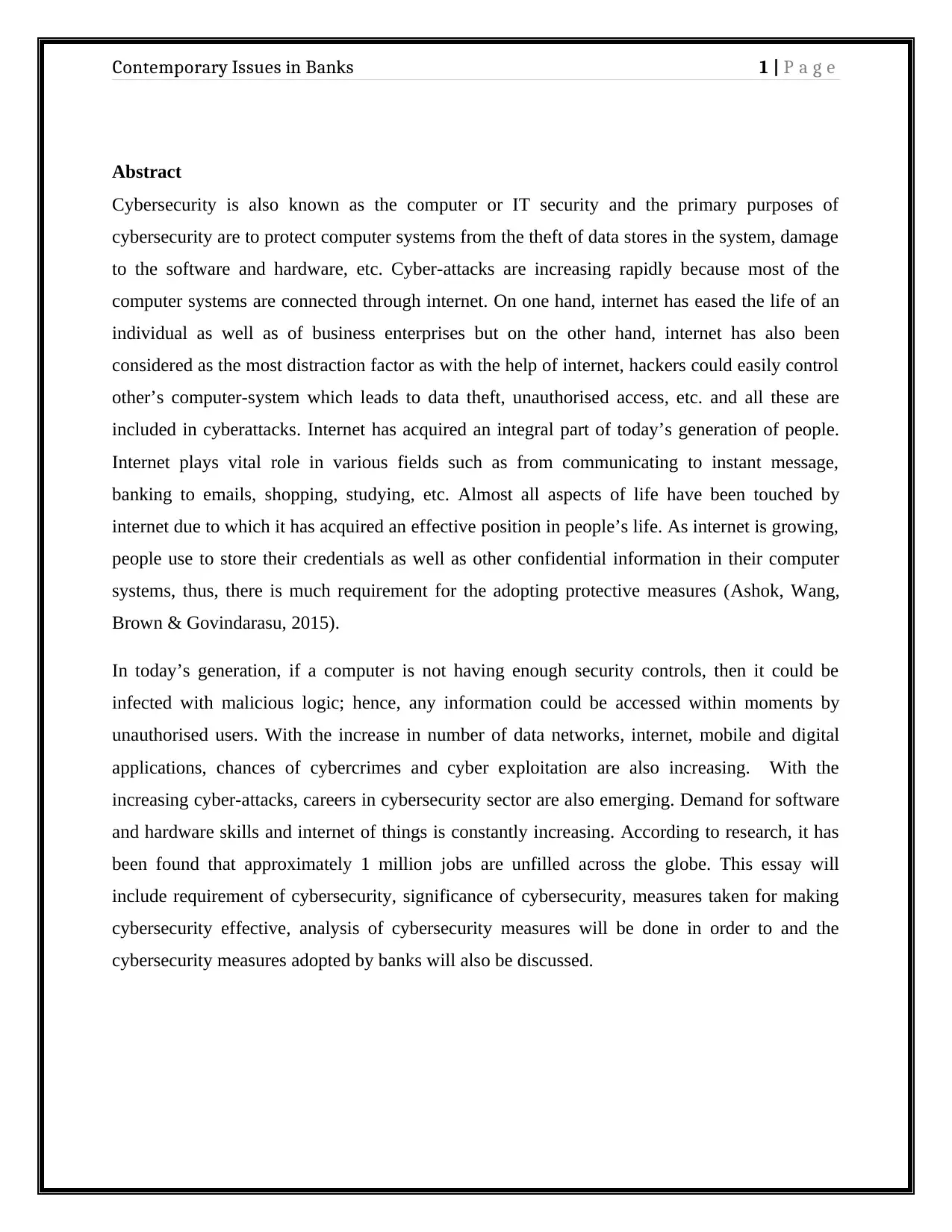
Contemporary Issues in Banks 1 | P a g e
Abstract
Cybersecurity is also known as the computer or IT security and the primary purposes of
cybersecurity are to protect computer systems from the theft of data stores in the system, damage
to the software and hardware, etc. Cyber-attacks are increasing rapidly because most of the
computer systems are connected through internet. On one hand, internet has eased the life of an
individual as well as of business enterprises but on the other hand, internet has also been
considered as the most distraction factor as with the help of internet, hackers could easily control
other’s computer-system which leads to data theft, unauthorised access, etc. and all these are
included in cyberattacks. Internet has acquired an integral part of today’s generation of people.
Internet plays vital role in various fields such as from communicating to instant message,
banking to emails, shopping, studying, etc. Almost all aspects of life have been touched by
internet due to which it has acquired an effective position in people’s life. As internet is growing,
people use to store their credentials as well as other confidential information in their computer
systems, thus, there is much requirement for the adopting protective measures (Ashok, Wang,
Brown & Govindarasu, 2015).
In today’s generation, if a computer is not having enough security controls, then it could be
infected with malicious logic; hence, any information could be accessed within moments by
unauthorised users. With the increase in number of data networks, internet, mobile and digital
applications, chances of cybercrimes and cyber exploitation are also increasing. With the
increasing cyber-attacks, careers in cybersecurity sector are also emerging. Demand for software
and hardware skills and internet of things is constantly increasing. According to research, it has
been found that approximately 1 million jobs are unfilled across the globe. This essay will
include requirement of cybersecurity, significance of cybersecurity, measures taken for making
cybersecurity effective, analysis of cybersecurity measures will be done in order to and the
cybersecurity measures adopted by banks will also be discussed.
Abstract
Cybersecurity is also known as the computer or IT security and the primary purposes of
cybersecurity are to protect computer systems from the theft of data stores in the system, damage
to the software and hardware, etc. Cyber-attacks are increasing rapidly because most of the
computer systems are connected through internet. On one hand, internet has eased the life of an
individual as well as of business enterprises but on the other hand, internet has also been
considered as the most distraction factor as with the help of internet, hackers could easily control
other’s computer-system which leads to data theft, unauthorised access, etc. and all these are
included in cyberattacks. Internet has acquired an integral part of today’s generation of people.
Internet plays vital role in various fields such as from communicating to instant message,
banking to emails, shopping, studying, etc. Almost all aspects of life have been touched by
internet due to which it has acquired an effective position in people’s life. As internet is growing,
people use to store their credentials as well as other confidential information in their computer
systems, thus, there is much requirement for the adopting protective measures (Ashok, Wang,
Brown & Govindarasu, 2015).
In today’s generation, if a computer is not having enough security controls, then it could be
infected with malicious logic; hence, any information could be accessed within moments by
unauthorised users. With the increase in number of data networks, internet, mobile and digital
applications, chances of cybercrimes and cyber exploitation are also increasing. With the
increasing cyber-attacks, careers in cybersecurity sector are also emerging. Demand for software
and hardware skills and internet of things is constantly increasing. According to research, it has
been found that approximately 1 million jobs are unfilled across the globe. This essay will
include requirement of cybersecurity, significance of cybersecurity, measures taken for making
cybersecurity effective, analysis of cybersecurity measures will be done in order to and the
cybersecurity measures adopted by banks will also be discussed.
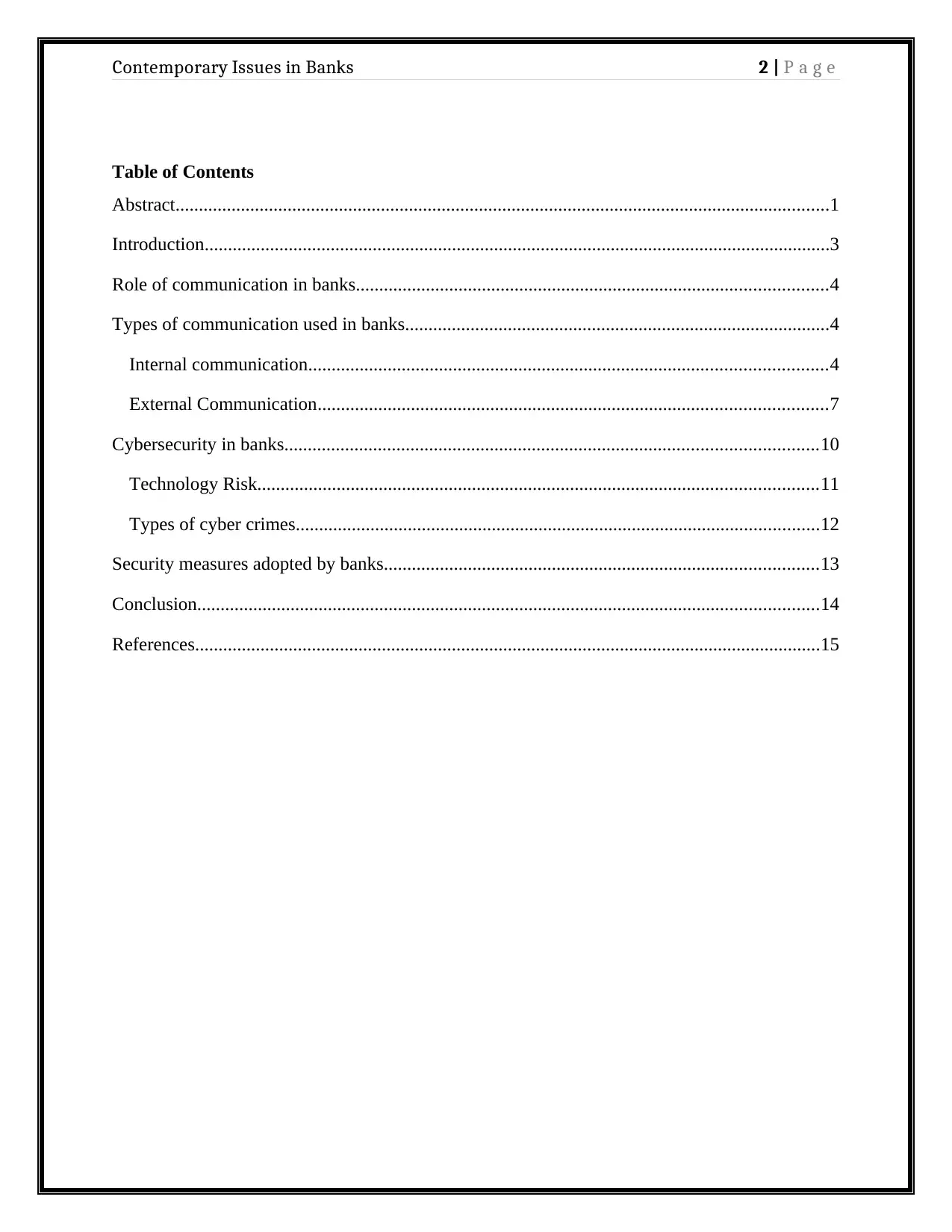
Contemporary Issues in Banks 2 | P a g e
Table of Contents
Abstract............................................................................................................................................1
Introduction......................................................................................................................................3
Role of communication in banks.....................................................................................................4
Types of communication used in banks...........................................................................................4
Internal communication...............................................................................................................4
External Communication.............................................................................................................7
Cybersecurity in banks..................................................................................................................10
Technology Risk........................................................................................................................11
Types of cyber crimes................................................................................................................12
Security measures adopted by banks.............................................................................................13
Conclusion.....................................................................................................................................14
References......................................................................................................................................15
Table of Contents
Abstract............................................................................................................................................1
Introduction......................................................................................................................................3
Role of communication in banks.....................................................................................................4
Types of communication used in banks...........................................................................................4
Internal communication...............................................................................................................4
External Communication.............................................................................................................7
Cybersecurity in banks..................................................................................................................10
Technology Risk........................................................................................................................11
Types of cyber crimes................................................................................................................12
Security measures adopted by banks.............................................................................................13
Conclusion.....................................................................................................................................14
References......................................................................................................................................15
⊘ This is a preview!⊘
Do you want full access?
Subscribe today to unlock all pages.

Trusted by 1+ million students worldwide
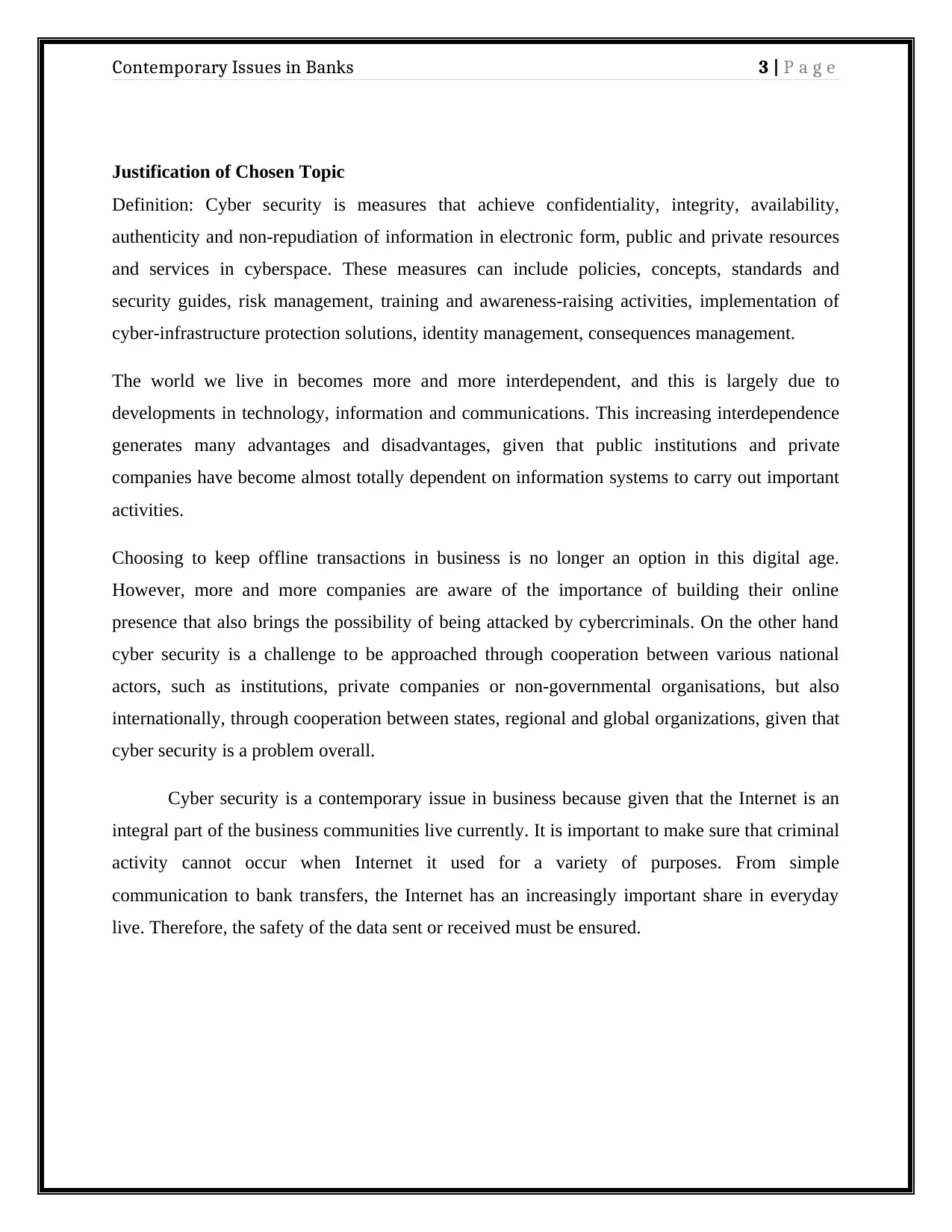
Contemporary Issues in Banks 3 | P a g e
Justification of Chosen Topic
Definition: Cyber security is measures that achieve confidentiality, integrity, availability,
authenticity and non-repudiation of information in electronic form, public and private resources
and services in cyberspace. These measures can include policies, concepts, standards and
security guides, risk management, training and awareness-raising activities, implementation of
cyber-infrastructure protection solutions, identity management, consequences management.
The world we live in becomes more and more interdependent, and this is largely due to
developments in technology, information and communications. This increasing interdependence
generates many advantages and disadvantages, given that public institutions and private
companies have become almost totally dependent on information systems to carry out important
activities.
Choosing to keep offline transactions in business is no longer an option in this digital age.
However, more and more companies are aware of the importance of building their online
presence that also brings the possibility of being attacked by cybercriminals. On the other hand
cyber security is a challenge to be approached through cooperation between various national
actors, such as institutions, private companies or non-governmental organisations, but also
internationally, through cooperation between states, regional and global organizations, given that
cyber security is a problem overall.
Cyber security is a contemporary issue in business because given that the Internet is an
integral part of the business communities live currently. It is important to make sure that criminal
activity cannot occur when Internet it used for a variety of purposes. From simple
communication to bank transfers, the Internet has an increasingly important share in everyday
live. Therefore, the safety of the data sent or received must be ensured.
Justification of Chosen Topic
Definition: Cyber security is measures that achieve confidentiality, integrity, availability,
authenticity and non-repudiation of information in electronic form, public and private resources
and services in cyberspace. These measures can include policies, concepts, standards and
security guides, risk management, training and awareness-raising activities, implementation of
cyber-infrastructure protection solutions, identity management, consequences management.
The world we live in becomes more and more interdependent, and this is largely due to
developments in technology, information and communications. This increasing interdependence
generates many advantages and disadvantages, given that public institutions and private
companies have become almost totally dependent on information systems to carry out important
activities.
Choosing to keep offline transactions in business is no longer an option in this digital age.
However, more and more companies are aware of the importance of building their online
presence that also brings the possibility of being attacked by cybercriminals. On the other hand
cyber security is a challenge to be approached through cooperation between various national
actors, such as institutions, private companies or non-governmental organisations, but also
internationally, through cooperation between states, regional and global organizations, given that
cyber security is a problem overall.
Cyber security is a contemporary issue in business because given that the Internet is an
integral part of the business communities live currently. It is important to make sure that criminal
activity cannot occur when Internet it used for a variety of purposes. From simple
communication to bank transfers, the Internet has an increasingly important share in everyday
live. Therefore, the safety of the data sent or received must be ensured.
Paraphrase This Document
Need a fresh take? Get an instant paraphrase of this document with our AI Paraphraser
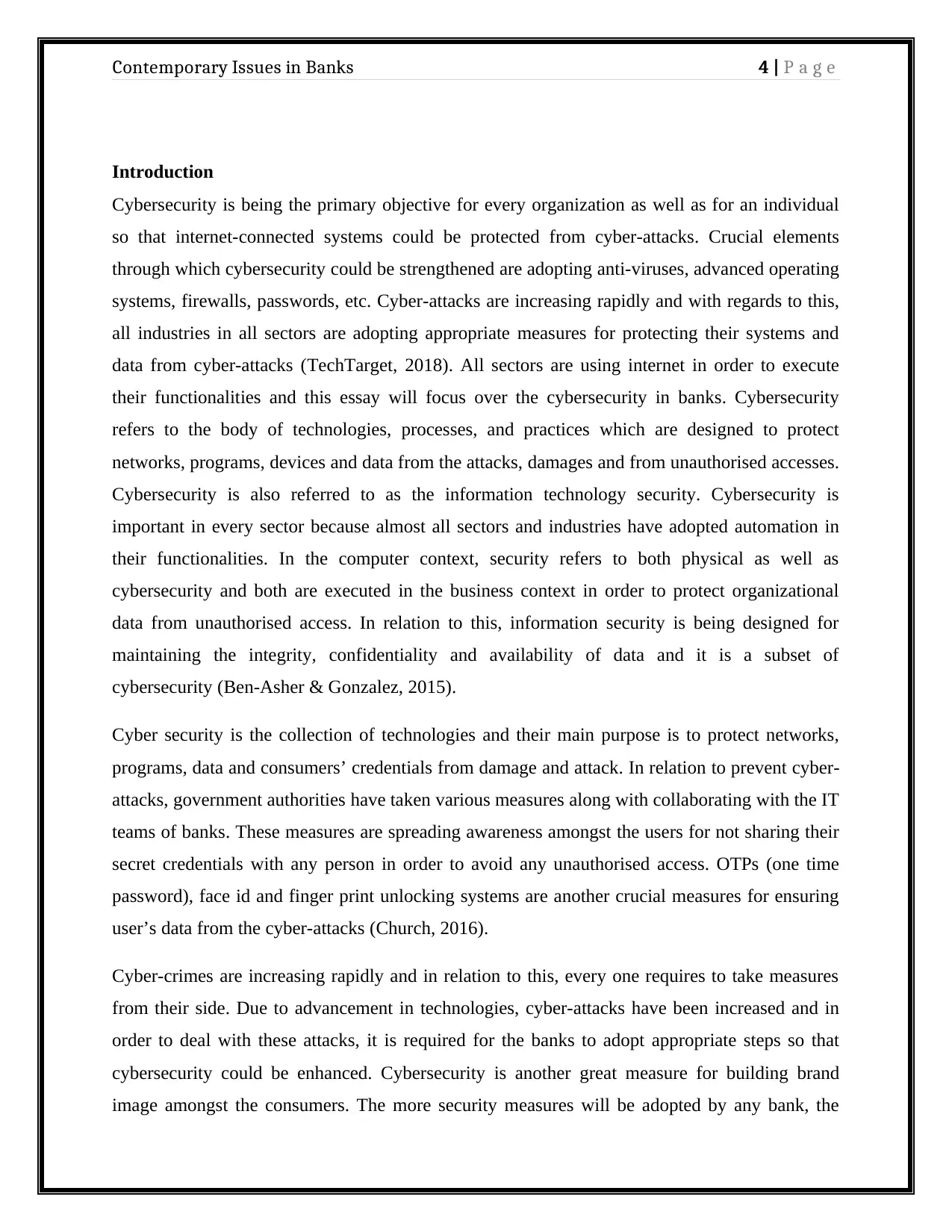
Contemporary Issues in Banks 4 | P a g e
Introduction
Cybersecurity is being the primary objective for every organization as well as for an individual
so that internet-connected systems could be protected from cyber-attacks. Crucial elements
through which cybersecurity could be strengthened are adopting anti-viruses, advanced operating
systems, firewalls, passwords, etc. Cyber-attacks are increasing rapidly and with regards to this,
all industries in all sectors are adopting appropriate measures for protecting their systems and
data from cyber-attacks (TechTarget, 2018). All sectors are using internet in order to execute
their functionalities and this essay will focus over the cybersecurity in banks. Cybersecurity
refers to the body of technologies, processes, and practices which are designed to protect
networks, programs, devices and data from the attacks, damages and from unauthorised accesses.
Cybersecurity is also referred to as the information technology security. Cybersecurity is
important in every sector because almost all sectors and industries have adopted automation in
their functionalities. In the computer context, security refers to both physical as well as
cybersecurity and both are executed in the business context in order to protect organizational
data from unauthorised access. In relation to this, information security is being designed for
maintaining the integrity, confidentiality and availability of data and it is a subset of
cybersecurity (Ben-Asher & Gonzalez, 2015).
Cyber security is the collection of technologies and their main purpose is to protect networks,
programs, data and consumers’ credentials from damage and attack. In relation to prevent cyber-
attacks, government authorities have taken various measures along with collaborating with the IT
teams of banks. These measures are spreading awareness amongst the users for not sharing their
secret credentials with any person in order to avoid any unauthorised access. OTPs (one time
password), face id and finger print unlocking systems are another crucial measures for ensuring
user’s data from the cyber-attacks (Church, 2016).
Cyber-crimes are increasing rapidly and in relation to this, every one requires to take measures
from their side. Due to advancement in technologies, cyber-attacks have been increased and in
order to deal with these attacks, it is required for the banks to adopt appropriate steps so that
cybersecurity could be enhanced. Cybersecurity is another great measure for building brand
image amongst the consumers. The more security measures will be adopted by any bank, the
Introduction
Cybersecurity is being the primary objective for every organization as well as for an individual
so that internet-connected systems could be protected from cyber-attacks. Crucial elements
through which cybersecurity could be strengthened are adopting anti-viruses, advanced operating
systems, firewalls, passwords, etc. Cyber-attacks are increasing rapidly and with regards to this,
all industries in all sectors are adopting appropriate measures for protecting their systems and
data from cyber-attacks (TechTarget, 2018). All sectors are using internet in order to execute
their functionalities and this essay will focus over the cybersecurity in banks. Cybersecurity
refers to the body of technologies, processes, and practices which are designed to protect
networks, programs, devices and data from the attacks, damages and from unauthorised accesses.
Cybersecurity is also referred to as the information technology security. Cybersecurity is
important in every sector because almost all sectors and industries have adopted automation in
their functionalities. In the computer context, security refers to both physical as well as
cybersecurity and both are executed in the business context in order to protect organizational
data from unauthorised access. In relation to this, information security is being designed for
maintaining the integrity, confidentiality and availability of data and it is a subset of
cybersecurity (Ben-Asher & Gonzalez, 2015).
Cyber security is the collection of technologies and their main purpose is to protect networks,
programs, data and consumers’ credentials from damage and attack. In relation to prevent cyber-
attacks, government authorities have taken various measures along with collaborating with the IT
teams of banks. These measures are spreading awareness amongst the users for not sharing their
secret credentials with any person in order to avoid any unauthorised access. OTPs (one time
password), face id and finger print unlocking systems are another crucial measures for ensuring
user’s data from the cyber-attacks (Church, 2016).
Cyber-crimes are increasing rapidly and in relation to this, every one requires to take measures
from their side. Due to advancement in technologies, cyber-attacks have been increased and in
order to deal with these attacks, it is required for the banks to adopt appropriate steps so that
cybersecurity could be enhanced. Cybersecurity is another great measure for building brand
image amongst the consumers. The more security measures will be adopted by any bank, the

Contemporary Issues in Banks 5 | P a g e
more number of customers will be attracted towards the bank. Cybersecurity is not only
important for banks, but it also plays significant role in protecting data for government, military,
financial institutions, organization who collects consumers’ data, etc. Amongst these
information, certain part of data could is sensitive enough through which huge loss could be
occurred. Cybersecurity is concerned with theft of data, hacking user’s computer system,
unauthorised access, etc. Cyber-attacks have been considered as one of the top threats to national
security since 2013 and it has even eclipsed terrorism (Craig, 2018).
more number of customers will be attracted towards the bank. Cybersecurity is not only
important for banks, but it also plays significant role in protecting data for government, military,
financial institutions, organization who collects consumers’ data, etc. Amongst these
information, certain part of data could is sensitive enough through which huge loss could be
occurred. Cybersecurity is concerned with theft of data, hacking user’s computer system,
unauthorised access, etc. Cyber-attacks have been considered as one of the top threats to national
security since 2013 and it has even eclipsed terrorism (Craig, 2018).
⊘ This is a preview!⊘
Do you want full access?
Subscribe today to unlock all pages.

Trusted by 1+ million students worldwide
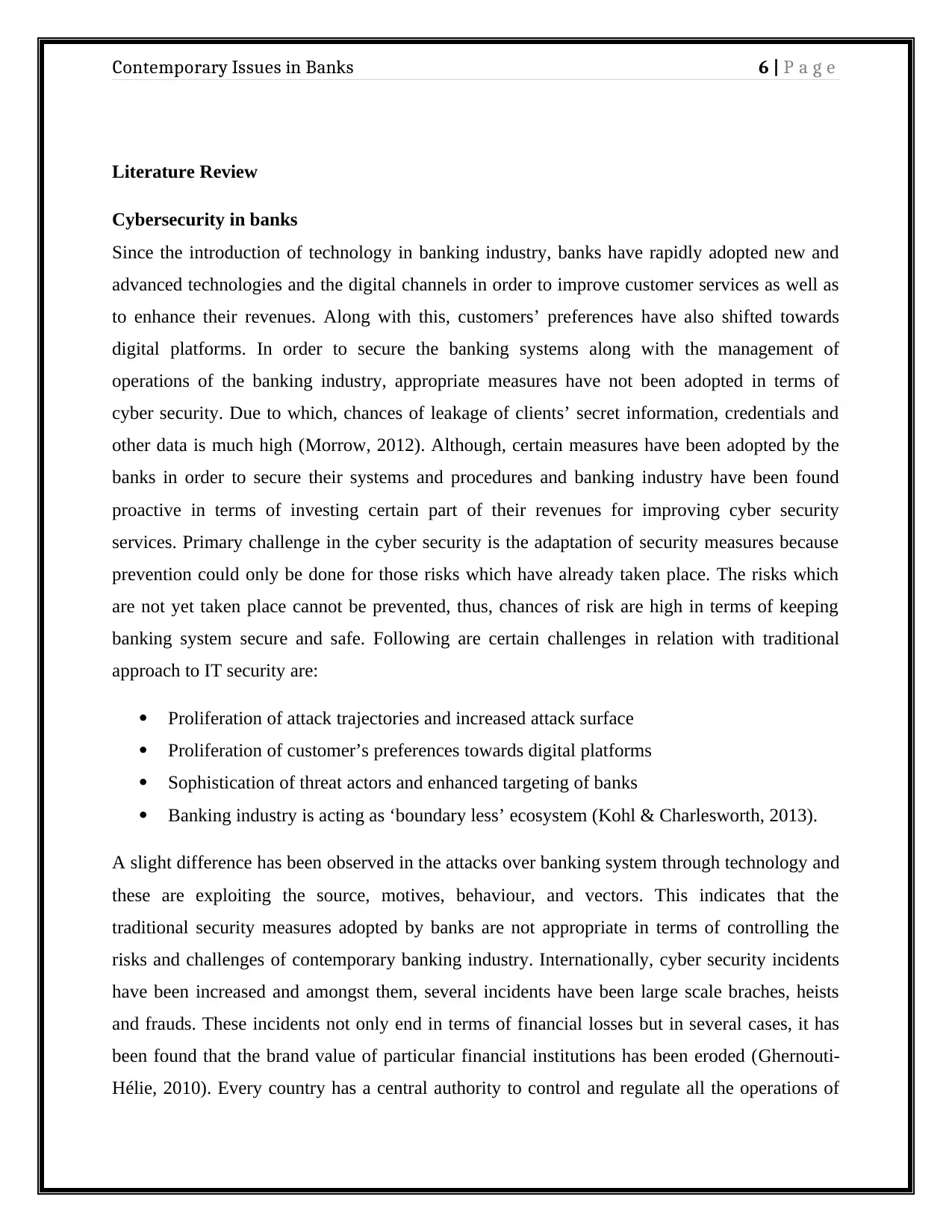
Contemporary Issues in Banks 6 | P a g e
Literature Review
Cybersecurity in banks
Since the introduction of technology in banking industry, banks have rapidly adopted new and
advanced technologies and the digital channels in order to improve customer services as well as
to enhance their revenues. Along with this, customers’ preferences have also shifted towards
digital platforms. In order to secure the banking systems along with the management of
operations of the banking industry, appropriate measures have not been adopted in terms of
cyber security. Due to which, chances of leakage of clients’ secret information, credentials and
other data is much high (Morrow, 2012). Although, certain measures have been adopted by the
banks in order to secure their systems and procedures and banking industry have been found
proactive in terms of investing certain part of their revenues for improving cyber security
services. Primary challenge in the cyber security is the adaptation of security measures because
prevention could only be done for those risks which have already taken place. The risks which
are not yet taken place cannot be prevented, thus, chances of risk are high in terms of keeping
banking system secure and safe. Following are certain challenges in relation with traditional
approach to IT security are:
Proliferation of attack trajectories and increased attack surface
Proliferation of customer’s preferences towards digital platforms
Sophistication of threat actors and enhanced targeting of banks
Banking industry is acting as ‘boundary less’ ecosystem (Kohl & Charlesworth, 2013).
A slight difference has been observed in the attacks over banking system through technology and
these are exploiting the source, motives, behaviour, and vectors. This indicates that the
traditional security measures adopted by banks are not appropriate in terms of controlling the
risks and challenges of contemporary banking industry. Internationally, cyber security incidents
have been increased and amongst them, several incidents have been large scale braches, heists
and frauds. These incidents not only end in terms of financial losses but in several cases, it has
been found that the brand value of particular financial institutions has been eroded (Ghernouti-
Hélie, 2010). Every country has a central authority to control and regulate all the operations of
Literature Review
Cybersecurity in banks
Since the introduction of technology in banking industry, banks have rapidly adopted new and
advanced technologies and the digital channels in order to improve customer services as well as
to enhance their revenues. Along with this, customers’ preferences have also shifted towards
digital platforms. In order to secure the banking systems along with the management of
operations of the banking industry, appropriate measures have not been adopted in terms of
cyber security. Due to which, chances of leakage of clients’ secret information, credentials and
other data is much high (Morrow, 2012). Although, certain measures have been adopted by the
banks in order to secure their systems and procedures and banking industry have been found
proactive in terms of investing certain part of their revenues for improving cyber security
services. Primary challenge in the cyber security is the adaptation of security measures because
prevention could only be done for those risks which have already taken place. The risks which
are not yet taken place cannot be prevented, thus, chances of risk are high in terms of keeping
banking system secure and safe. Following are certain challenges in relation with traditional
approach to IT security are:
Proliferation of attack trajectories and increased attack surface
Proliferation of customer’s preferences towards digital platforms
Sophistication of threat actors and enhanced targeting of banks
Banking industry is acting as ‘boundary less’ ecosystem (Kohl & Charlesworth, 2013).
A slight difference has been observed in the attacks over banking system through technology and
these are exploiting the source, motives, behaviour, and vectors. This indicates that the
traditional security measures adopted by banks are not appropriate in terms of controlling the
risks and challenges of contemporary banking industry. Internationally, cyber security incidents
have been increased and amongst them, several incidents have been large scale braches, heists
and frauds. These incidents not only end in terms of financial losses but in several cases, it has
been found that the brand value of particular financial institutions has been eroded (Ghernouti-
Hélie, 2010). Every country has a central authority to control and regulate all the operations of
Paraphrase This Document
Need a fresh take? Get an instant paraphrase of this document with our AI Paraphraser
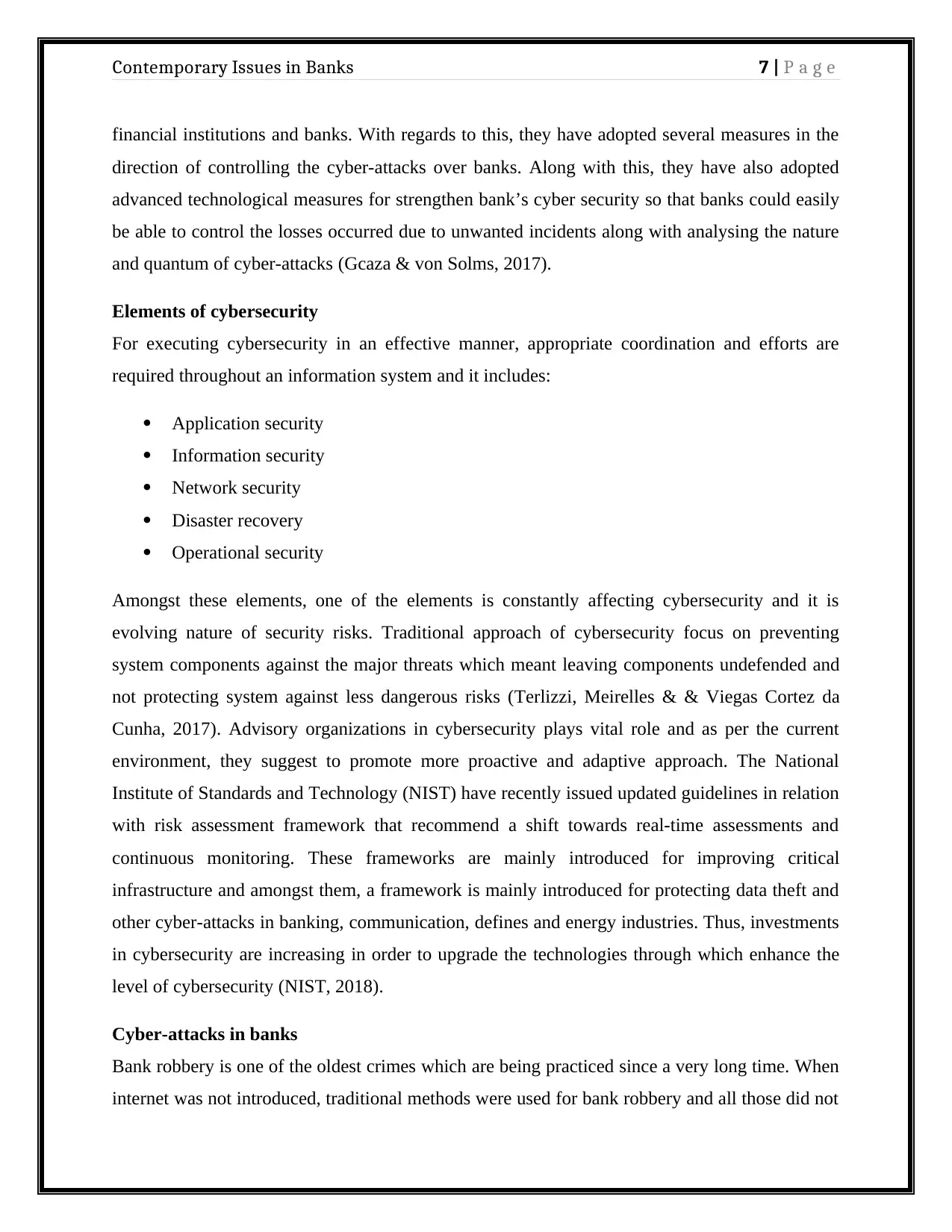
Contemporary Issues in Banks 7 | P a g e
financial institutions and banks. With regards to this, they have adopted several measures in the
direction of controlling the cyber-attacks over banks. Along with this, they have also adopted
advanced technological measures for strengthen bank’s cyber security so that banks could easily
be able to control the losses occurred due to unwanted incidents along with analysing the nature
and quantum of cyber-attacks (Gcaza & von Solms, 2017).
Elements of cybersecurity
For executing cybersecurity in an effective manner, appropriate coordination and efforts are
required throughout an information system and it includes:
Application security
Information security
Network security
Disaster recovery
Operational security
Amongst these elements, one of the elements is constantly affecting cybersecurity and it is
evolving nature of security risks. Traditional approach of cybersecurity focus on preventing
system components against the major threats which meant leaving components undefended and
not protecting system against less dangerous risks (Terlizzi, Meirelles & & Viegas Cortez da
Cunha, 2017). Advisory organizations in cybersecurity plays vital role and as per the current
environment, they suggest to promote more proactive and adaptive approach. The National
Institute of Standards and Technology (NIST) have recently issued updated guidelines in relation
with risk assessment framework that recommend a shift towards real-time assessments and
continuous monitoring. These frameworks are mainly introduced for improving critical
infrastructure and amongst them, a framework is mainly introduced for protecting data theft and
other cyber-attacks in banking, communication, defines and energy industries. Thus, investments
in cybersecurity are increasing in order to upgrade the technologies through which enhance the
level of cybersecurity (NIST, 2018).
Cyber-attacks in banks
Bank robbery is one of the oldest crimes which are being practiced since a very long time. When
internet was not introduced, traditional methods were used for bank robbery and all those did not
financial institutions and banks. With regards to this, they have adopted several measures in the
direction of controlling the cyber-attacks over banks. Along with this, they have also adopted
advanced technological measures for strengthen bank’s cyber security so that banks could easily
be able to control the losses occurred due to unwanted incidents along with analysing the nature
and quantum of cyber-attacks (Gcaza & von Solms, 2017).
Elements of cybersecurity
For executing cybersecurity in an effective manner, appropriate coordination and efforts are
required throughout an information system and it includes:
Application security
Information security
Network security
Disaster recovery
Operational security
Amongst these elements, one of the elements is constantly affecting cybersecurity and it is
evolving nature of security risks. Traditional approach of cybersecurity focus on preventing
system components against the major threats which meant leaving components undefended and
not protecting system against less dangerous risks (Terlizzi, Meirelles & & Viegas Cortez da
Cunha, 2017). Advisory organizations in cybersecurity plays vital role and as per the current
environment, they suggest to promote more proactive and adaptive approach. The National
Institute of Standards and Technology (NIST) have recently issued updated guidelines in relation
with risk assessment framework that recommend a shift towards real-time assessments and
continuous monitoring. These frameworks are mainly introduced for improving critical
infrastructure and amongst them, a framework is mainly introduced for protecting data theft and
other cyber-attacks in banking, communication, defines and energy industries. Thus, investments
in cybersecurity are increasing in order to upgrade the technologies through which enhance the
level of cybersecurity (NIST, 2018).
Cyber-attacks in banks
Bank robbery is one of the oldest crimes which are being practiced since a very long time. When
internet was not introduced, traditional methods were used for bank robbery and all those did not
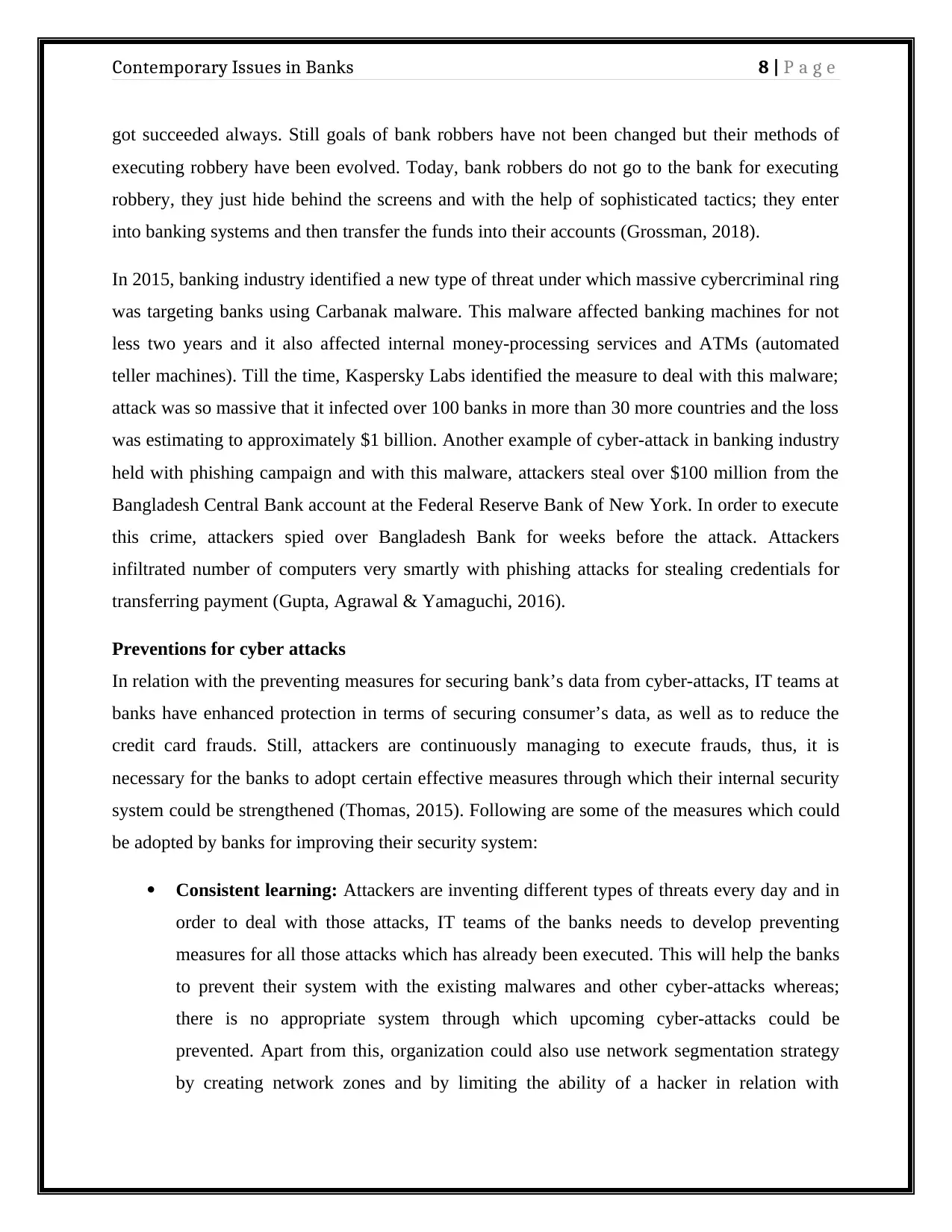
Contemporary Issues in Banks 8 | P a g e
got succeeded always. Still goals of bank robbers have not been changed but their methods of
executing robbery have been evolved. Today, bank robbers do not go to the bank for executing
robbery, they just hide behind the screens and with the help of sophisticated tactics; they enter
into banking systems and then transfer the funds into their accounts (Grossman, 2018).
In 2015, banking industry identified a new type of threat under which massive cybercriminal ring
was targeting banks using Carbanak malware. This malware affected banking machines for not
less two years and it also affected internal money-processing services and ATMs (automated
teller machines). Till the time, Kaspersky Labs identified the measure to deal with this malware;
attack was so massive that it infected over 100 banks in more than 30 more countries and the loss
was estimating to approximately $1 billion. Another example of cyber-attack in banking industry
held with phishing campaign and with this malware, attackers steal over $100 million from the
Bangladesh Central Bank account at the Federal Reserve Bank of New York. In order to execute
this crime, attackers spied over Bangladesh Bank for weeks before the attack. Attackers
infiltrated number of computers very smartly with phishing attacks for stealing credentials for
transferring payment (Gupta, Agrawal & Yamaguchi, 2016).
Preventions for cyber attacks
In relation with the preventing measures for securing bank’s data from cyber-attacks, IT teams at
banks have enhanced protection in terms of securing consumer’s data, as well as to reduce the
credit card frauds. Still, attackers are continuously managing to execute frauds, thus, it is
necessary for the banks to adopt certain effective measures through which their internal security
system could be strengthened (Thomas, 2015). Following are some of the measures which could
be adopted by banks for improving their security system:
Consistent learning: Attackers are inventing different types of threats every day and in
order to deal with those attacks, IT teams of the banks needs to develop preventing
measures for all those attacks which has already been executed. This will help the banks
to prevent their system with the existing malwares and other cyber-attacks whereas;
there is no appropriate system through which upcoming cyber-attacks could be
prevented. Apart from this, organization could also use network segmentation strategy
by creating network zones and by limiting the ability of a hacker in relation with
got succeeded always. Still goals of bank robbers have not been changed but their methods of
executing robbery have been evolved. Today, bank robbers do not go to the bank for executing
robbery, they just hide behind the screens and with the help of sophisticated tactics; they enter
into banking systems and then transfer the funds into their accounts (Grossman, 2018).
In 2015, banking industry identified a new type of threat under which massive cybercriminal ring
was targeting banks using Carbanak malware. This malware affected banking machines for not
less two years and it also affected internal money-processing services and ATMs (automated
teller machines). Till the time, Kaspersky Labs identified the measure to deal with this malware;
attack was so massive that it infected over 100 banks in more than 30 more countries and the loss
was estimating to approximately $1 billion. Another example of cyber-attack in banking industry
held with phishing campaign and with this malware, attackers steal over $100 million from the
Bangladesh Central Bank account at the Federal Reserve Bank of New York. In order to execute
this crime, attackers spied over Bangladesh Bank for weeks before the attack. Attackers
infiltrated number of computers very smartly with phishing attacks for stealing credentials for
transferring payment (Gupta, Agrawal & Yamaguchi, 2016).
Preventions for cyber attacks
In relation with the preventing measures for securing bank’s data from cyber-attacks, IT teams at
banks have enhanced protection in terms of securing consumer’s data, as well as to reduce the
credit card frauds. Still, attackers are continuously managing to execute frauds, thus, it is
necessary for the banks to adopt certain effective measures through which their internal security
system could be strengthened (Thomas, 2015). Following are some of the measures which could
be adopted by banks for improving their security system:
Consistent learning: Attackers are inventing different types of threats every day and in
order to deal with those attacks, IT teams of the banks needs to develop preventing
measures for all those attacks which has already been executed. This will help the banks
to prevent their system with the existing malwares and other cyber-attacks whereas;
there is no appropriate system through which upcoming cyber-attacks could be
prevented. Apart from this, organization could also use network segmentation strategy
by creating network zones and by limiting the ability of a hacker in relation with
⊘ This is a preview!⊘
Do you want full access?
Subscribe today to unlock all pages.

Trusted by 1+ million students worldwide
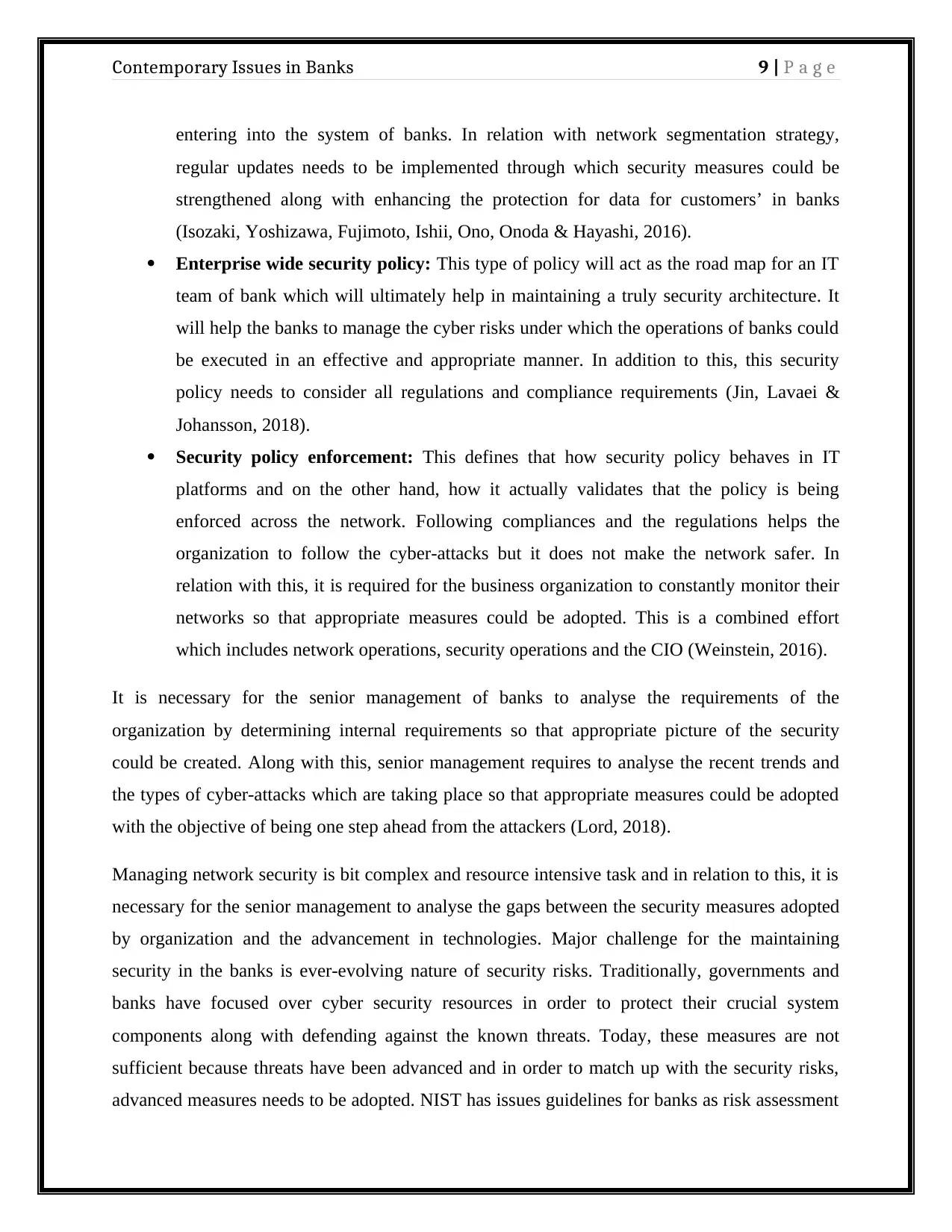
Contemporary Issues in Banks 9 | P a g e
entering into the system of banks. In relation with network segmentation strategy,
regular updates needs to be implemented through which security measures could be
strengthened along with enhancing the protection for data for customers’ in banks
(Isozaki, Yoshizawa, Fujimoto, Ishii, Ono, Onoda & Hayashi, 2016).
Enterprise wide security policy: This type of policy will act as the road map for an IT
team of bank which will ultimately help in maintaining a truly security architecture. It
will help the banks to manage the cyber risks under which the operations of banks could
be executed in an effective and appropriate manner. In addition to this, this security
policy needs to consider all regulations and compliance requirements (Jin, Lavaei &
Johansson, 2018).
Security policy enforcement: This defines that how security policy behaves in IT
platforms and on the other hand, how it actually validates that the policy is being
enforced across the network. Following compliances and the regulations helps the
organization to follow the cyber-attacks but it does not make the network safer. In
relation with this, it is required for the business organization to constantly monitor their
networks so that appropriate measures could be adopted. This is a combined effort
which includes network operations, security operations and the CIO (Weinstein, 2016).
It is necessary for the senior management of banks to analyse the requirements of the
organization by determining internal requirements so that appropriate picture of the security
could be created. Along with this, senior management requires to analyse the recent trends and
the types of cyber-attacks which are taking place so that appropriate measures could be adopted
with the objective of being one step ahead from the attackers (Lord, 2018).
Managing network security is bit complex and resource intensive task and in relation to this, it is
necessary for the senior management to analyse the gaps between the security measures adopted
by organization and the advancement in technologies. Major challenge for the maintaining
security in the banks is ever-evolving nature of security risks. Traditionally, governments and
banks have focused over cyber security resources in order to protect their crucial system
components along with defending against the known threats. Today, these measures are not
sufficient because threats have been advanced and in order to match up with the security risks,
advanced measures needs to be adopted. NIST has issues guidelines for banks as risk assessment
entering into the system of banks. In relation with network segmentation strategy,
regular updates needs to be implemented through which security measures could be
strengthened along with enhancing the protection for data for customers’ in banks
(Isozaki, Yoshizawa, Fujimoto, Ishii, Ono, Onoda & Hayashi, 2016).
Enterprise wide security policy: This type of policy will act as the road map for an IT
team of bank which will ultimately help in maintaining a truly security architecture. It
will help the banks to manage the cyber risks under which the operations of banks could
be executed in an effective and appropriate manner. In addition to this, this security
policy needs to consider all regulations and compliance requirements (Jin, Lavaei &
Johansson, 2018).
Security policy enforcement: This defines that how security policy behaves in IT
platforms and on the other hand, how it actually validates that the policy is being
enforced across the network. Following compliances and the regulations helps the
organization to follow the cyber-attacks but it does not make the network safer. In
relation with this, it is required for the business organization to constantly monitor their
networks so that appropriate measures could be adopted. This is a combined effort
which includes network operations, security operations and the CIO (Weinstein, 2016).
It is necessary for the senior management of banks to analyse the requirements of the
organization by determining internal requirements so that appropriate picture of the security
could be created. Along with this, senior management requires to analyse the recent trends and
the types of cyber-attacks which are taking place so that appropriate measures could be adopted
with the objective of being one step ahead from the attackers (Lord, 2018).
Managing network security is bit complex and resource intensive task and in relation to this, it is
necessary for the senior management to analyse the gaps between the security measures adopted
by organization and the advancement in technologies. Major challenge for the maintaining
security in the banks is ever-evolving nature of security risks. Traditionally, governments and
banks have focused over cyber security resources in order to protect their crucial system
components along with defending against the known threats. Today, these measures are not
sufficient because threats have been advanced and in order to match up with the security risks,
advanced measures needs to be adopted. NIST has issues guidelines for banks as risk assessment
Paraphrase This Document
Need a fresh take? Get an instant paraphrase of this document with our AI Paraphraser
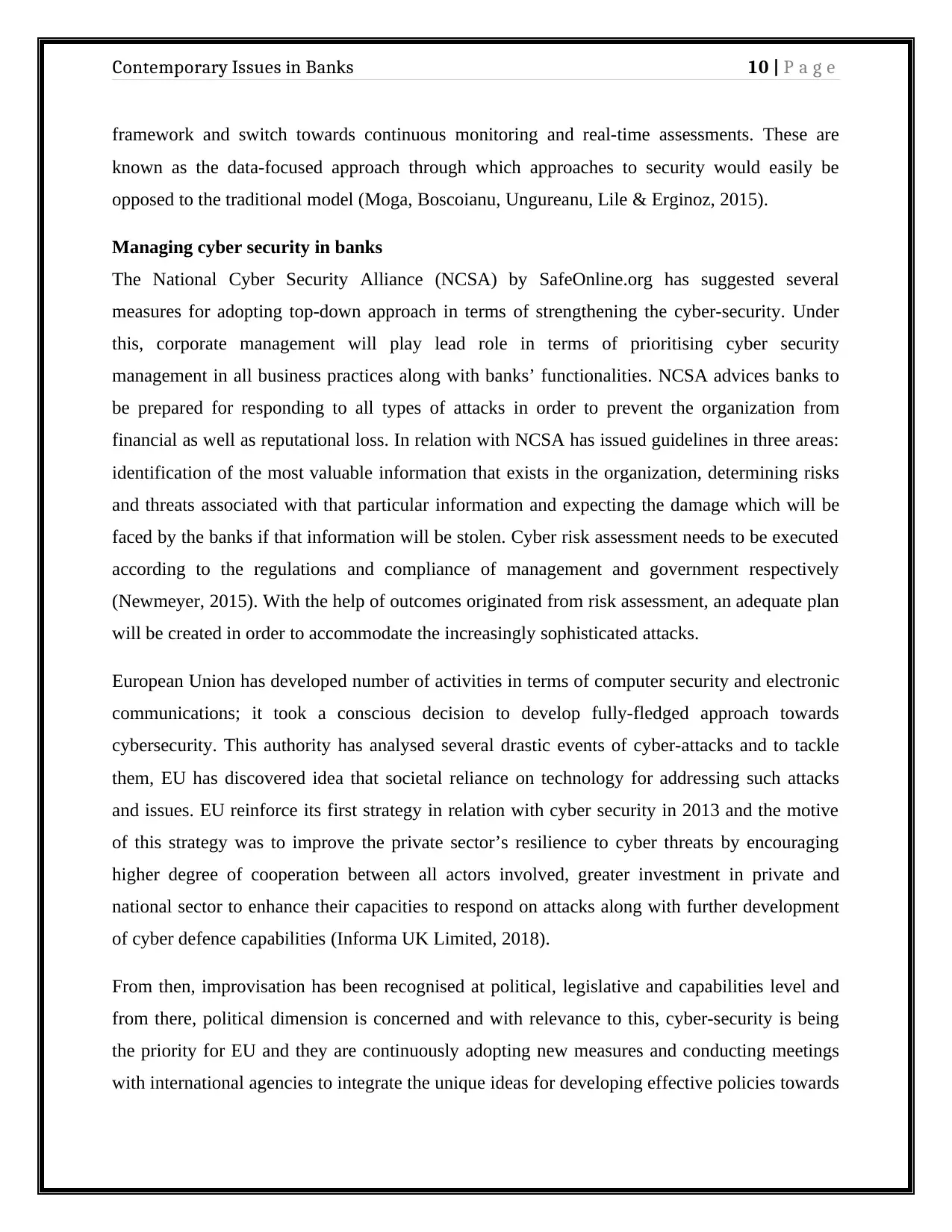
Contemporary Issues in Banks 10 | P a g e
framework and switch towards continuous monitoring and real-time assessments. These are
known as the data-focused approach through which approaches to security would easily be
opposed to the traditional model (Moga, Boscoianu, Ungureanu, Lile & Erginoz, 2015).
Managing cyber security in banks
The National Cyber Security Alliance (NCSA) by SafeOnline.org has suggested several
measures for adopting top-down approach in terms of strengthening the cyber-security. Under
this, corporate management will play lead role in terms of prioritising cyber security
management in all business practices along with banks’ functionalities. NCSA advices banks to
be prepared for responding to all types of attacks in order to prevent the organization from
financial as well as reputational loss. In relation with NCSA has issued guidelines in three areas:
identification of the most valuable information that exists in the organization, determining risks
and threats associated with that particular information and expecting the damage which will be
faced by the banks if that information will be stolen. Cyber risk assessment needs to be executed
according to the regulations and compliance of management and government respectively
(Newmeyer, 2015). With the help of outcomes originated from risk assessment, an adequate plan
will be created in order to accommodate the increasingly sophisticated attacks.
European Union has developed number of activities in terms of computer security and electronic
communications; it took a conscious decision to develop fully-fledged approach towards
cybersecurity. This authority has analysed several drastic events of cyber-attacks and to tackle
them, EU has discovered idea that societal reliance on technology for addressing such attacks
and issues. EU reinforce its first strategy in relation with cyber security in 2013 and the motive
of this strategy was to improve the private sector’s resilience to cyber threats by encouraging
higher degree of cooperation between all actors involved, greater investment in private and
national sector to enhance their capacities to respond on attacks along with further development
of cyber defence capabilities (Informa UK Limited, 2018).
From then, improvisation has been recognised at political, legislative and capabilities level and
from there, political dimension is concerned and with relevance to this, cyber-security is being
the priority for EU and they are continuously adopting new measures and conducting meetings
with international agencies to integrate the unique ideas for developing effective policies towards
framework and switch towards continuous monitoring and real-time assessments. These are
known as the data-focused approach through which approaches to security would easily be
opposed to the traditional model (Moga, Boscoianu, Ungureanu, Lile & Erginoz, 2015).
Managing cyber security in banks
The National Cyber Security Alliance (NCSA) by SafeOnline.org has suggested several
measures for adopting top-down approach in terms of strengthening the cyber-security. Under
this, corporate management will play lead role in terms of prioritising cyber security
management in all business practices along with banks’ functionalities. NCSA advices banks to
be prepared for responding to all types of attacks in order to prevent the organization from
financial as well as reputational loss. In relation with NCSA has issued guidelines in three areas:
identification of the most valuable information that exists in the organization, determining risks
and threats associated with that particular information and expecting the damage which will be
faced by the banks if that information will be stolen. Cyber risk assessment needs to be executed
according to the regulations and compliance of management and government respectively
(Newmeyer, 2015). With the help of outcomes originated from risk assessment, an adequate plan
will be created in order to accommodate the increasingly sophisticated attacks.
European Union has developed number of activities in terms of computer security and electronic
communications; it took a conscious decision to develop fully-fledged approach towards
cybersecurity. This authority has analysed several drastic events of cyber-attacks and to tackle
them, EU has discovered idea that societal reliance on technology for addressing such attacks
and issues. EU reinforce its first strategy in relation with cyber security in 2013 and the motive
of this strategy was to improve the private sector’s resilience to cyber threats by encouraging
higher degree of cooperation between all actors involved, greater investment in private and
national sector to enhance their capacities to respond on attacks along with further development
of cyber defence capabilities (Informa UK Limited, 2018).
From then, improvisation has been recognised at political, legislative and capabilities level and
from there, political dimension is concerned and with relevance to this, cyber-security is being
the priority for EU and they are continuously adopting new measures and conducting meetings
with international agencies to integrate the unique ideas for developing effective policies towards
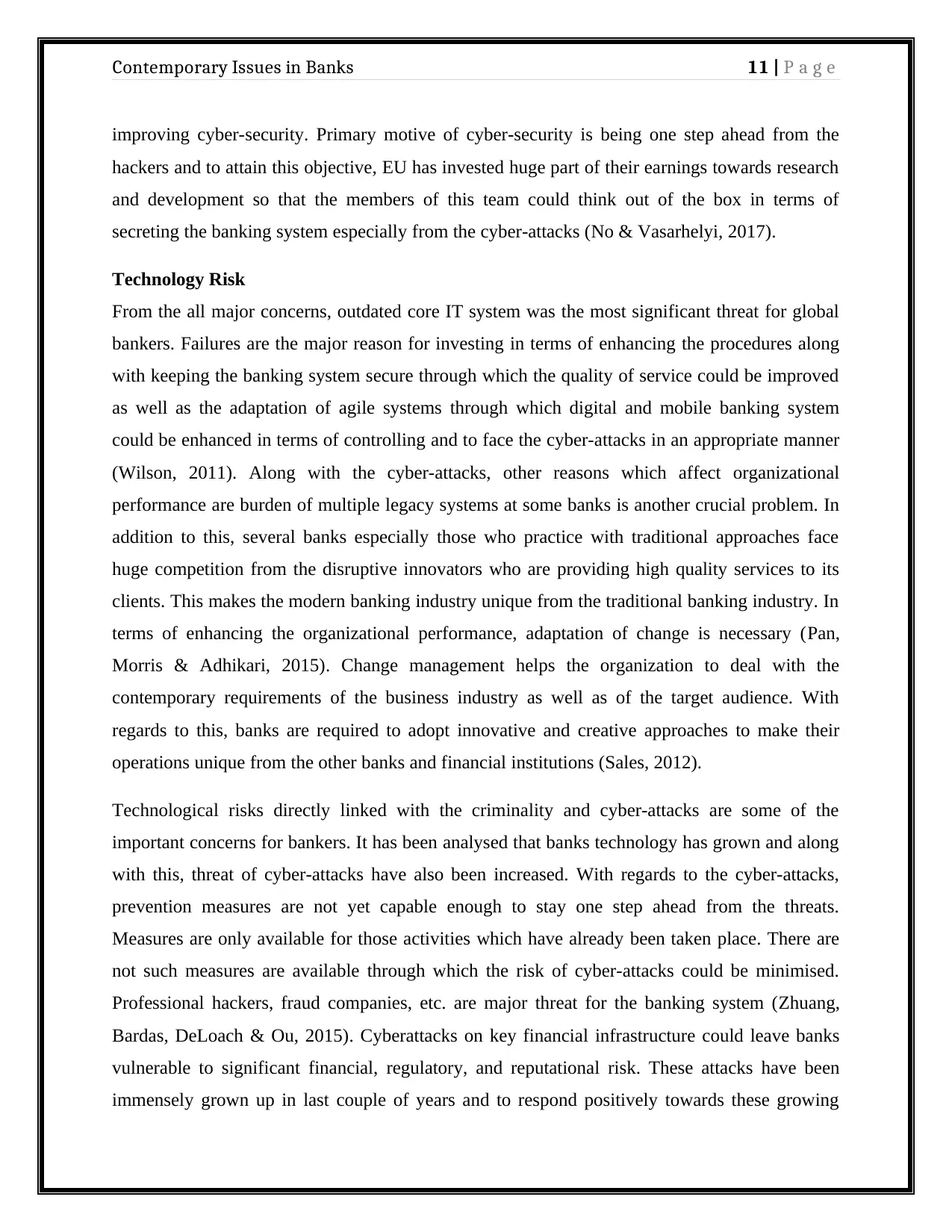
Contemporary Issues in Banks 11 | P a g e
improving cyber-security. Primary motive of cyber-security is being one step ahead from the
hackers and to attain this objective, EU has invested huge part of their earnings towards research
and development so that the members of this team could think out of the box in terms of
secreting the banking system especially from the cyber-attacks (No & Vasarhelyi, 2017).
Technology Risk
From the all major concerns, outdated core IT system was the most significant threat for global
bankers. Failures are the major reason for investing in terms of enhancing the procedures along
with keeping the banking system secure through which the quality of service could be improved
as well as the adaptation of agile systems through which digital and mobile banking system
could be enhanced in terms of controlling and to face the cyber-attacks in an appropriate manner
(Wilson, 2011). Along with the cyber-attacks, other reasons which affect organizational
performance are burden of multiple legacy systems at some banks is another crucial problem. In
addition to this, several banks especially those who practice with traditional approaches face
huge competition from the disruptive innovators who are providing high quality services to its
clients. This makes the modern banking industry unique from the traditional banking industry. In
terms of enhancing the organizational performance, adaptation of change is necessary (Pan,
Morris & Adhikari, 2015). Change management helps the organization to deal with the
contemporary requirements of the business industry as well as of the target audience. With
regards to this, banks are required to adopt innovative and creative approaches to make their
operations unique from the other banks and financial institutions (Sales, 2012).
Technological risks directly linked with the criminality and cyber-attacks are some of the
important concerns for bankers. It has been analysed that banks technology has grown and along
with this, threat of cyber-attacks have also been increased. With regards to the cyber-attacks,
prevention measures are not yet capable enough to stay one step ahead from the threats.
Measures are only available for those activities which have already been taken place. There are
not such measures are available through which the risk of cyber-attacks could be minimised.
Professional hackers, fraud companies, etc. are major threat for the banking system (Zhuang,
Bardas, DeLoach & Ou, 2015). Cyberattacks on key financial infrastructure could leave banks
vulnerable to significant financial, regulatory, and reputational risk. These attacks have been
immensely grown up in last couple of years and to respond positively towards these growing
improving cyber-security. Primary motive of cyber-security is being one step ahead from the
hackers and to attain this objective, EU has invested huge part of their earnings towards research
and development so that the members of this team could think out of the box in terms of
secreting the banking system especially from the cyber-attacks (No & Vasarhelyi, 2017).
Technology Risk
From the all major concerns, outdated core IT system was the most significant threat for global
bankers. Failures are the major reason for investing in terms of enhancing the procedures along
with keeping the banking system secure through which the quality of service could be improved
as well as the adaptation of agile systems through which digital and mobile banking system
could be enhanced in terms of controlling and to face the cyber-attacks in an appropriate manner
(Wilson, 2011). Along with the cyber-attacks, other reasons which affect organizational
performance are burden of multiple legacy systems at some banks is another crucial problem. In
addition to this, several banks especially those who practice with traditional approaches face
huge competition from the disruptive innovators who are providing high quality services to its
clients. This makes the modern banking industry unique from the traditional banking industry. In
terms of enhancing the organizational performance, adaptation of change is necessary (Pan,
Morris & Adhikari, 2015). Change management helps the organization to deal with the
contemporary requirements of the business industry as well as of the target audience. With
regards to this, banks are required to adopt innovative and creative approaches to make their
operations unique from the other banks and financial institutions (Sales, 2012).
Technological risks directly linked with the criminality and cyber-attacks are some of the
important concerns for bankers. It has been analysed that banks technology has grown and along
with this, threat of cyber-attacks have also been increased. With regards to the cyber-attacks,
prevention measures are not yet capable enough to stay one step ahead from the threats.
Measures are only available for those activities which have already been taken place. There are
not such measures are available through which the risk of cyber-attacks could be minimised.
Professional hackers, fraud companies, etc. are major threat for the banking system (Zhuang,
Bardas, DeLoach & Ou, 2015). Cyberattacks on key financial infrastructure could leave banks
vulnerable to significant financial, regulatory, and reputational risk. These attacks have been
immensely grown up in last couple of years and to respond positively towards these growing
⊘ This is a preview!⊘
Do you want full access?
Subscribe today to unlock all pages.

Trusted by 1+ million students worldwide
1 out of 21
Related Documents
Your All-in-One AI-Powered Toolkit for Academic Success.
+13062052269
info@desklib.com
Available 24*7 on WhatsApp / Email
![[object Object]](/_next/static/media/star-bottom.7253800d.svg)
Unlock your academic potential
Copyright © 2020–2025 A2Z Services. All Rights Reserved. Developed and managed by ZUCOL.



